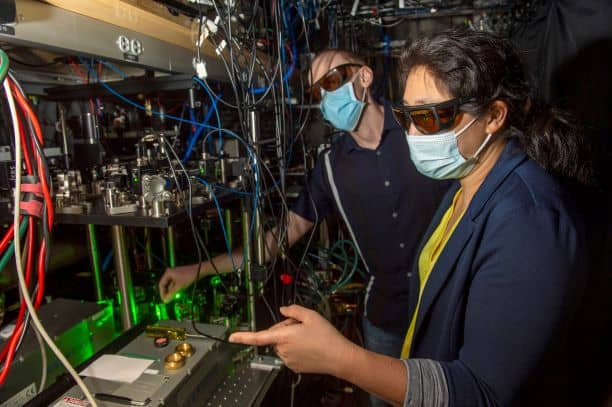Cold chemistry with COVID precautions: Kang-Kuen Ni (right) and postdoctoral researcher Matthew A Nichols during a visit to the laboratory. Most of their experiments were carried out remotely. (Courtesy: Jon Chase/Harvard Staff Photographer)”>
Chemical reactions are complex. Even if only a few molecules are involved, the final configuration will depend on a huge number of parameters – including, in principle, all the possible locations each electron in each atom can occupy as the reaction takes place. Calculating these trajectories is beyond the power of today’s best computers, but researchers led by Kang-Kuen Ni of Harvard University in the US have now demonstrated an alternative. By cooling molecules of potassium and rubidium down to a fraction of a degree above absolute zero, they reduced the number of possible reaction outcomes to just 57. They then probed all these outcomes down to the level of individual quantum states, paving the way for a better understanding of chemistry.
When molecules are cooled close to 0 K, they enter their absolute quantum mechanical ground state, with the lowest possible levels of electronic, vibrational and rotational energy. Additionally, their kinetic energy, which governs their movement through space, becomes vanishingly small. Ultracold molecules are therefore an ideal test bed for validating quantum-dynamical models of reactions.
Ultracold KRb reactions
In their study, which is published in Nature, Ni and her colleagues focused on the reaction that occurs when ultracold potassium-rubidium (KRb) molecules exchange atoms to form K2 and Rb2. This reaction releases energy (it is exoergic), but the energy released is not sufficient to excite vibrational motion in the product molecules. This means that all the energy must instead go into rotational and translational motion (recoil energy).
Under these conditions, a quantum statistical model that includes conservation of energy conservation and angular momentum predicts that the number of possible joint quantum state pairs in the product molecules is relatively small, at 57. However, measuring these states is still no easy task and requires special techniques.
The researchers detect the rotational states of their K2 and Rb2 molecules by ionizing them with a laser pulse. The ionization process is selective, occurring only when the laser frequency matches the gap in the molecules’ energy levels, which is different for each rotational state. The ionized molecules then fly through a series of circular electrodes (all integrated into the reaction chamber), at which point electric fields propel them towards a position-sensitive detector. Once the researchers mapped how often a particular rotational state originated from the reaction, they changed the laser frequency to match the energy levels of the next rotational state and repeated the process until the survey was complete.
Ni and colleagues also needed to determine whether the molecules they detected were produced in the same reaction event. For this, they applied the principle of conservation of linear momentum. When two KRb molecules of similar momenta collide, the resulting K2 and Br2 molecules fly away from each other with equal but opposite momenta. This means the product molecules arrive at the detector at different locations, but their arrival can be correlated. This correlation enabled the researchers to distinguish reaction products from molecules that originated in other processes.
Quantum-dynamical model
In a series of experiments (most of which were run remotely to comply with COVID restrictions), the Harvard team measured the scattering probabilities for all 57 allowed rotational state-pairs of the products. They found that while 50 of these probabilities matched theoretical predictions, the remaining seven did not. In one of these non-matching outcomes, the reaction took place close to the threshold of the exoergic energy, where most of the energy couples only to rotational motion. This leaves very little recoil energy for the reaction products to fly apart and get detected, meaning that the lack of theoretical agreement could be an artefact of the team’s measurement system. The other deviations, however, have no straightforward explanation, and contradict the prediction that all product states should have an equal probability of forming.

Physicists fine tune chemical reaction rates for ultracold molecules
“For many physical chemists it’s been a long-term dream to be able to follow a chemical reaction from start to finish at the quantum state resolved level,” Ni says. “In this work, we achieved that.” Ni notes that the deviations they observed “may not be understood for another 10-20 years, until perhaps a quantum computer solves the quantum reaction dynamics calculations”. However, she concludes, “the data is there for future benchmarking of theory for when that becomes available”.
“A significant achievement”
Balakrishnan Naduvalath, a physical chemist at the University of Nevada in Las Vegas, US, who was not involved in the study, says that precisely mapping the quantum states of reaction products is “a significant achievement that no other research group has accomplished for a bimolecular chemical reaction in the ultracold regime”. The experiment, he adds, “provides much deeper insights into chemistry and at the same time challenges theory. The availability of experimental results surely would motivate theorists to develop new methodologies (and benchmark them) to study this class of four-atom reactions that might also benefit other areas of chemistry.”
As a next step, members of the Harvard team plan to put their system to work on molecule-to-atom reactions, which are less complex, and for which the available theoretical predictions are more accurate. They also hope to leverage such reactions to generate quantum entanglement resources.
